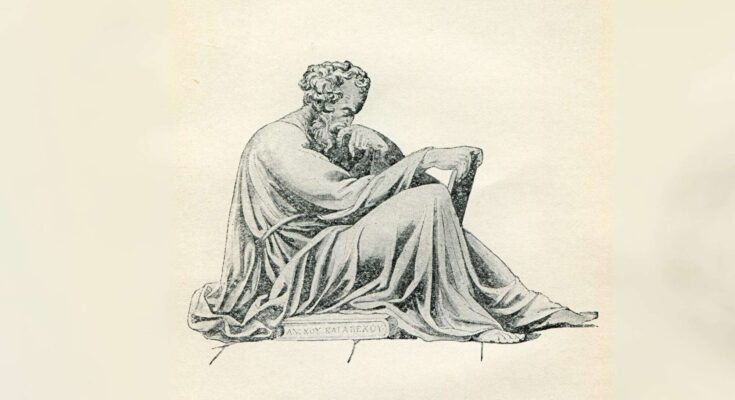The unique quality of the Greek language lies in the fact that the phoneme of a word and the meaning of that word are mostly identical.
The signifier and the signified are two important terms in the use of language. The signifier is the object, the word, the image or action. The signified is the concept behind the object that is being represented. The Greek language is unique in that the signifier and the signified are most often the same word.
This quality appeared as early as the late 6th century BC in Greek tragedy. The word philanthropy (‘philanthropia’ in Greek), for example, is defined as love for man: “Philo ton anthropon” means “love for mankind.” Hence, the signifier (philanthropy) and the signified (love for mankind) are the same word.
Alternatively, the Greek word for statue is agalma. It derives from the verb ‘agallomai,’ which means “I rejoice, I am pleased.” It describes the pleasure one gets when admiring an ancient Greek statue with the perfect lines, the beautiful physique, the expression, and the emotion it depicts. Therefore, the word agalma not only describes the physical marble creation but also the emotion it sparks in the viewer of the statue.
When a Roman and a Greek see a statue (‘statuam’ in Latin), both know what it is. However, the Latin word only describes the object. The Greek word not only describes the object, however, but also the feeling that the statue may induce in the observer.
In both cases, the word used (the signifier) and the description of the subject, object, concept, or idea (the signified) are one and the same.
To explain the difference between languages, in English, the word “statue” describes a static sculpture but not the feelings of the person viewing the statue.
From the Stoics to Ferdinand de Saussure
The distinction “signified – signifier” goes back to the Stoics, who put great emphasis on language and semiotics. They studied the relationship of language—mind—world and established the distinction of the word as a sign into signifier and signified.
However, this distinction between the meaning of a word (the signified) and the way of declaring the meaning (signifier) corresponds, in practice, to an old, broader, and more general distinction of language in content and form.
The main Stoic sources are biographer of Greek philosophers Diogenes Laertius (3rd century AD) and Greek philosopher and physician Sextus Empiricus (2nd century-early 3rd century AD). Sextus Empiricus highlighted the importance the Stoics put on the sign as an essential concept in human rationality and a threefold division consisting of the signifier, the signified, and the existent.
However, the man who highlighted and established this distinction in linguistics and, consequently, in many other areas of the social sciences is Ferdinand de Saussure (1857-1913).
The Swiss linguist, semiotician, and philosopher created a theory of the word and the sign. He is the proponent of the study of the linguistic sign and, together with the term semiology, Saussure searched into the structure of the word as a unique conventional combination of a certain signified (meaning) with a certain phthongic statement (signifier).
Saussure posits that this combination is conventional, not causal. He uses the term “arbitrary,” which is not accepted today, and in relation to the very substance of the word, he shows that the signified (the meaning) is a mental entity. It is information that exists in our mind about how the meaning of a word is expressed in a certain language.
Given that this relationship is conventional (established, according to Aristotle), we will not find it in other languages unless they belong to the same language family.
From signifier and signified to four basic aspects
According to Greek linguist Georgios Babiniotis, the signifier-signified linguistic dualism is inherent in all human language, but especially in Greek. All communication is also dualistic. It has a signifier and a signified. It has the level of the message, content, or information and the level of the form, statement, or, in other words, the expression of the content.
In any case, we have the what and the how. The same happens in a text, and here we have content and form, signified and signifier. In a text, the signified is made up of a complex set of information with many functions, which lead to a correspondingly complex form of the signifier of the text.
Finally, because the relationship between content and form is never 1:1, there is always the possibility of choices, which is the most creative process of language, Babiniotis argues.
For Saussure, signifier and signified constitute the internal side of the linguistic sign (the word) and correspond externally—the signified to some object to which it refers (“reference object”) and the signifier to a succession of syllables that declare it sonically or to a specific representation of letters, often historically determined (“historical orthography”), in the written word.
Therefore, there are four basic aspects of a word, or four pieces of information. These are the signified (meaning), the signifier (word), the object of reference (to which the signified refers), and the sound of the word (what the speaker articulates and the interlocutor hears).
The terms ‘signifier’ and ‘signified’ established by Saussure resonated in the linguistic work of modern French constructivists such as Roland Barthes, Claude Lévi-Strauss, Michel Foucault, Jacques Lacan, Jacques Derrida et al.



